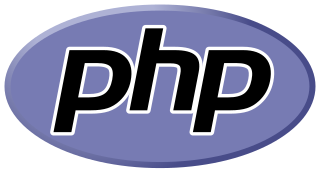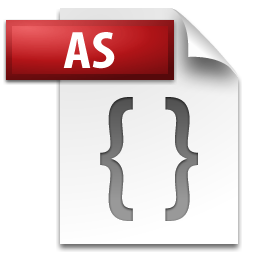The Portable Operating System Interface is a family of standards specified by the IEEE Computer Society for maintaining compatibility between operating systems. POSIX defines application programming interfaces (APIs), along with command line shells and utility interfaces, for software compatibility (portability) with variants of Unix and other operating systems. POSIX is also a trademark of the IEEE. POSIX is intended to be used by both application and system developers.

PHP is a general-purpose scripting language geared towards web development. It was originally created by Danish-Canadian programmer Rasmus Lerdorf in 1993 and released in 1995. The PHP reference implementation is now produced by the PHP Group. PHP was originally an abbreviation of Personal Home Page, but it now stands for the recursive acronym PHP: Hypertext Preprocessor.
Rebol is a cross-platform data exchange language and a multi-paradigm dynamic programming language designed by Carl Sassenrath for network communications and distributed computing. It introduces the concept of dialecting: small, optimized, domain-specific languages for code and data, which is also the most notable property of the language according to its designer Carl Sassenrath:
Although it can be used for programming, writing functions, and performing processes, its greatest strength is the ability to easily create domain-specific languages or dialects
troff, short for "typesetter roff", is the major component of a document processing system developed by Bell Labs for the Unix operating system. troff and the related nroff were both developed from the original roff.

In computer science, a thread of execution is the smallest sequence of programmed instructions that can be managed independently by a scheduler, which is typically a part of the operating system. In many cases, a thread is a component of a process.
Programming languages can be grouped by the number and types of paradigms supported.
The C standard library, sometimes referred to as libc, is the standard library for the C programming language, as specified in the ISO C standard. Starting from the original ANSI C standard, it was developed at the same time as the C library POSIX specification, which is a superset of it. Since ANSI C was adopted by the International Organization for Standardization, the C standard library is also called the ISO C library.

In computing, a visual programming language, also known as diagrammatic programming, graphical programming or block coding, is a programming language that lets users create programs by manipulating program elements graphically rather than by specifying them textually. A VPL allows programming with visual expressions, spatial arrangements of text and graphic symbols, used either as elements of syntax or secondary notation. For example, many VPLs are based on the idea of "boxes and arrows", where boxes or other screen objects are treated as entities, connected by arrows, lines or arcs which represent relations. VPLs are generally the basis of Low-code development platforms.

ActionScript is an object-oriented programming language originally developed by Macromedia Inc.. It is influenced by HyperTalk, the scripting language for HyperCard. It is now an implementation of ECMAScript, though it originally arose as a sibling, both being influenced by HyperTalk. ActionScript code is usually converted to bytecode format by a compiler.
m4 is a general-purpose macro processor included in most Unix-like operating systems, and is a component of the POSIX standard.

OpenSceneGraph is an open-source 3D graphics application programming interface, used by application developers in fields such as visual simulation, computer games, virtual reality, scientific visualization and modeling.
Concurrent computing is a form of computing in which several computations are executed concurrently—during overlapping time periods—instead of sequentially—with one completing before the next starts.
Charm++ is a parallel object-oriented programming paradigm based on C++ and developed in the Parallel Programming Laboratory at the University of Illinois at Urbana–Champaign. Charm++ is designed with the goal of enhancing programmer productivity by providing a high-level abstraction of a parallel program while at the same time delivering good performance on a wide variety of underlying hardware platforms. Programs written in Charm++ are decomposed into a number of cooperating message-driven objects called chares. When a programmer invokes a method on an object, the Charm++ runtime system sends a message to the invoked object, which may reside on the local processor or on a remote processor in a parallel computation. This message triggers the execution of code within the chare to handle the message asynchronously.

AmigaOS is a family of proprietary native operating systems of the Amiga and AmigaOne personal computers. It was developed first by Commodore International and introduced with the launch of the first Amiga, the Amiga 1000, in 1985. Early versions of AmigaOS required the Motorola 68000 series of 16-bit and 32-bit microprocessors. Later versions, after Commodore's demise, were developed by Haage & Partner and then Hyperion Entertainment. A PowerPC microprocessor is required for the most recent release, AmigaOS 4.
An application programming interface (API) is a connection between computers or between computer programs. It is a type of software interface, offering a service to other pieces of software. A document or standard that describes how to build such a connection or interface is called an API specification. A computer system that meets this standard is said to implement or expose an API. The term API may refer either to the specification or to the implementation.

Ciao is a general-purpose programming language which supports logic, constraint, functional, higher-order, and object-oriented programming styles. Its main design objectives are high expressive power, extensibility, safety, reliability, and efficient execution.
Seed7 is an extensible general-purpose programming language designed by Thomas Mertes. It is syntactically similar to Pascal and Ada. Along with many other features, it provides an extension mechanism. Seed7 supports introducing new syntax elements and their semantics into the language, and allows new language constructs to be defined and written in Seed7. For example, programmers can introduce syntax and semantics of new statements and user defined operator symbols. The implementation of Seed7 differs significantly from that of languages with hard-coded syntax and semantics.

Art of Illusion is a free software, and open source software package for making 3D graphics.





